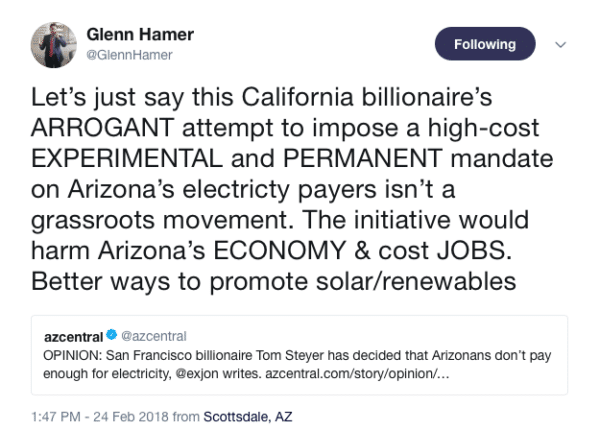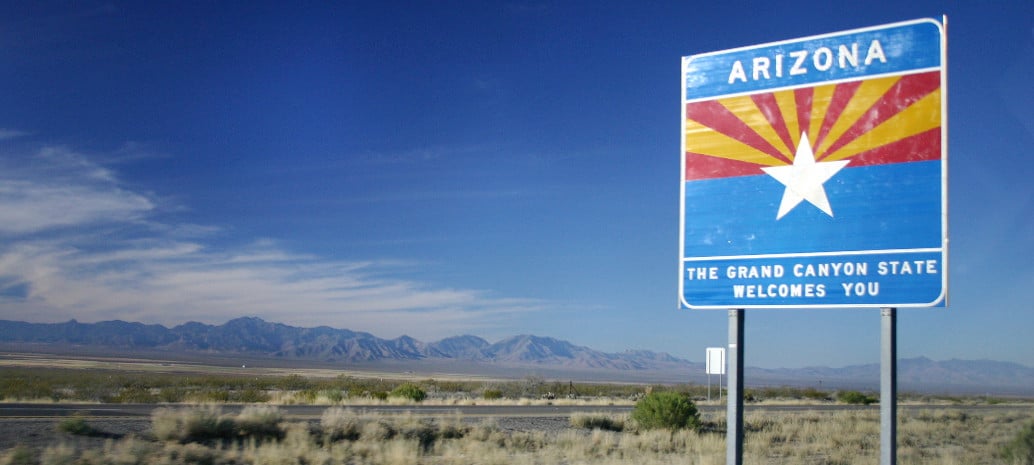There is never a dull moment in Arizona politics. Two weeks after a state regulator put forward a plan for utilities to source 80% of their electricity from “clean” energy by 2050, activists in the state filed for a ballot initiative calling for a constitutional amendment to require that the state to source 50% of its electricity from renewable energy by 2030. This is the same target that has been adopted in California and New York.
This would include a mandate that 10% of the state’s electricity come from distributed sources like rooftop solar.
On the same day and likely before the ink was dry on that filing, a political action group backed by utility Arizona Public Service (APS) parent company Pinnacle West registered with the Secretary of State’s office to oppose the ballot initiative. Matthew Benson, the former director of communications for Arizona Governor Jan Brewer, has been representing “Arizonans for Affordable Electricity”.
Based upon Benson’s public statements, so far this appears to mean making unsupported statements about the alleged impacts on utility rates, including citing similar statements by Arizona Chamber of Commerce and Industry (ACCI) President and CEO Glenn Hamer. The 50% by 2030 goal has its own celebrity backer, California billionaire Tom Steyer, who Hamer has been focusing on in a series of angry tweets incorporating liberal and seemingly uncontrolled use of the caps lock key.

Hamer and Benson’s statements regarding electricity prices is particularly odd given that large-scale solar has become one of the cheapest forms of electricity in high-irradiation locations like Arizona, and that in many places in the western United States wind is even cheaper.
As for APS’ opposition to the plan, this may be due to a preference for gas. An analysis by Energy and Policy Institute notes that APS’ 2017 Integrated Resource Plan (IRP) shows that the utility plans to increase its use of gas from 26% to 32% of its annual generation over the next four years, and increase again slightly over the following decade.
Another interesting feature of the IRP is that while nuclear generation declines in APS’ plan, that it remains at 17% in 2032. APS is a partial owner of the massive Palo Verde nuclear power plant, one of the few remaining nuclear power plants in the western United States and at 3.3 GW the largest power plant of any kind in the nation.
It is notable that Tobin’s 80% “clean” energy by 2050 proposal does not appear to have drawn the same fire from APS that the Steyer-backed 50% by 2030 renewable energy plan does. This may be due to the 10% carve-out for behind-the-meter resources, which Tobin’s plan lacks; or it may be that nuclear power is being included in the 80%.
The 50% by 2030 ballot initiative is one of only several efforts that are currently underway to increase state-level renewable energy mandates in the United States. Steyer is backing similar ballot initiatives in Michigan and Nevada, but he is far from alone.
A Connecticut bill to increase the state’s renewable energy mandate is backed by the current governor, and we have seen no indication that either this or a similar bill in Maryland is associated with Steyer.
This content is protected by copyright and may not be reused. If you want to cooperate with us and would like to reuse some of our content, please contact: editors@pv-magazine.com.









By submitting this form you agree to pv magazine using your data for the purposes of publishing your comment.
Your personal data will only be disclosed or otherwise transmitted to third parties for the purposes of spam filtering or if this is necessary for technical maintenance of the website. Any other transfer to third parties will not take place unless this is justified on the basis of applicable data protection regulations or if pv magazine is legally obliged to do so.
You may revoke this consent at any time with effect for the future, in which case your personal data will be deleted immediately. Otherwise, your data will be deleted if pv magazine has processed your request or the purpose of data storage is fulfilled.
Further information on data privacy can be found in our Data Protection Policy.